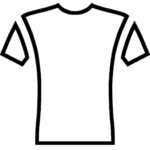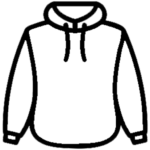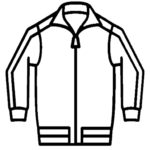Currently, thermal transfer printing technology is being applied by many garment factories because of its outstanding efficiency. Compared with the direct thermal printing method, this printing technique helps to achieve high-quality products and sharper images. So what are the heat transfer printing technique, their pros, and cons? Answer in the article below.
1. What is heat transfer printing?
Thermal transfer Printer is a digital printing technology that uses technology to heat a ribbon coating and stick it to the material to be printed. Normally, heat transfer printing on shirts is divided into two main stages: printing on paper and then heat pressing so that the print can stick to the shirt.

This method is one of the three most modern groups of thermal printing technologies today, namely thermal printing, dye sublimation, and thermal wax transfer. This printing technique was invented by the SATO Group in Japan with the first SATO M-2311 printer born in 1982. The reason this printing technology is preferred is that the product has high quality. Better quality, sharper, and more durable.

2. Fabric heat transfer printing methods
When applying this printing technique, the craftsman will look at the fabric color to have a suitable printing method. Because each different fabric color will significantly affect the choice of color to print clearly on the shirt. Here are 2 printing technologies on dark and light spandex fabrics.
2.1. Heat transfer printing technology on dark t-shirt fabric
For dark T-shirts, it is very difficult to print pictures and words so clearly and beautifully. Because currently, no technology can print light colors on dark T-shirts.
Therefore, in this case, paper with two layers of the film is used. It is a type of paper that has a hard film on one side and a heat-resistant rubber film on the other side. Then, you proceed to print the image on the heat-resistant rubber film and press a part of the rubber film onto the fabric’s surface.

2.2. Heat transfer printing technology on bright T-shirts
Compared to dark fabrics, the application of heat transfer printing technology on light-colored shirts is much simpler. The background of the shirt is a light color, you can print any color, except white, which also produces a clear and eye-catching image.
Choosing paper for printing is very easy, you can choose pink base paper or Sublimation paper imported from Korea. Regarding the material, you can choose a shirt with high PE content that will help the image transition to be optimized and more durable. In particular, you need to pay attention to choosing the material of the t-shirts to ensure the desired image quality after printing.

3. Advantages and disadvantages of thermal transfer printing
For thermal transfer printing technology on fabric, compared to direct printing, there are many outstanding advantages. However, this technique also has some disadvantages that are not easily overcome.
3.1. Advantages
The print is sharp and the printing technique is more advanced than the direct printing method.
Flexible printing in any position on the shirt, convenient for sewing.
Very good printability and color retention, color saturation, and accurate color temperature make the product colorfast, less peeling, and water-absorbent.
The printing method is very simple and uses modern machinery as the main, which saves time and effort for workers.
Any pattern can be printed according to the customer’s request.
Besides printing on fabric, you can also apply printing on other materials such as wood, ceramics, paper, etc. to be able to customize different light and dark colors according to the user’s liking.
3.2. Defect
The biggest limitation of this printing technique is that it can not print on all material surfaces, only on flat and wide surfaces.
Cannot print on soft fusible materials such as plastic bags.
Only the heat transfer capacity of the ink and the material can be used for some common materials such as cloth, wood, ceramics, and paper, and cannot be printed on raw materials.
This printing technique is not compatible with fabrics that are not heat resistant, it can only print on synthetic fabrics made of poly fibers.
The technology is only suitable for printing on white fabrics, it is difficult to print on dark fabrics. For fabrics of other colors, the printed image is easily contaminated with fabric color, incorrect color printing, and not the desired results.
It is easy to be discolored if the printed material is stretched.
4. Current types of thermal transfer printers
After learning the process above, you will surely notice that thermal transfer printing requires machinery and equipment. So do you know what type of machine is being used commonly today?

Theoretically, all thermal transfer printers have the same structure and operation, only different in the heat press mold and the way the machine is operated. The essence of the thermal transfer printing method is to use heat and strong pressure to force the printed image from the thermal transfer paper to the surface of the material. Therefore, the injection mold must be designed as close to the surface of the material as possible. Here are some of the most common types of thermal transfer printers:
-Flatbed heat transfer printer: Used to print fabric, shirts, glass, wood, mica, and ceramic tile…
-Thermal transfer printer on cups: Used to press glass, porcelain, and plastic cups…
-On-disk thermal transfer printer: Used to print dishes and have only a certain mold.
-Thermal transfer printer on hats: Used to print cloth hats, caps, and helmets.
5. What is thermal transfer ink?
Thermal transfer ink is simply the type of ink used for printing by thermal transfer. The choice of ink type is very important for the success of the printing process. With good ink, the image to be printed will be sharper, more vivid, and more durable. The inks can be converted from solid to gas without liquefaction thanks to a special coating, which allows the ink to easily penetrate the surface of the material and make the image brighter, more vivid, and more realistic.

-The working principle is as follows:
-Pressing ink under high heat causes the ink to evaporate and move on the surface of the printed paper.
-They then open small holes in the surface of the paper for the dye vapor to enter, causing the dye vapor to transfer from the surface of the paper to the surface of the material to be printed.
-When the heating is stopped, the temperature drops, the pores are sealed and the dye changes from vapor to solid rapidly.
6. What is thermal transfer paper?
Thermal transfer paper is a type of paper whose surface is impregnated with a very hot chemical layer, called a mixture of LEUCO Fluoran (dye) and Octadecylphosphonic Acid. This is a type of paper that, when pressed at high temperature, will melt the dye, transferring the printed image on the paper to the surface of the material to be printed.
-The working principle is as follows:
-The original image is printed with thermal transfer ink on the paper.
-Then use a high-temperature press to transfer the image to be printed onto the surface of the material.
-Thermal transfer paper will upload images and colors to materials with an accuracy of up to 90% on materials such as light-colored fabrics, glass, wood, ceramics, etc.



 T-shirts
T-shirts
 Polo T-shirts
Polo T-shirts
 Embroidery
Embroidery
 Sweatshirts & Hoodies
Sweatshirts & Hoodies
 Women's clothing
Women's clothing
 Kid's clothing
Kid's clothing
 Hats
Hats
 Featured Brand
Featured Brand
 Bar & Restaurant
Bar & Restaurant
 Construction
Construction
 Conventions / Expos
Conventions / Expos
 Medical
Medical
 Nails / beauty salon ..
Nails / beauty salon ..
 Events & Celebrations
Events & Celebrations
 4th of July
4th of July
 Black History Month
Black History Month
 Christmas
Christmas
 Fathers Day
Fathers Day
 Halloween
Halloween
 Animal Causes
Animal Causes
 Autism
Autism
 Cancer
Cancer
 Non-Profits
Non-Profits
 Walks / Runs / Marathons
Walks / Runs / Marathons
 Sports & Teams
Sports & Teams
 Baseball
Baseball
 Basketball
Basketball
 Badminton
Badminton
 Bowling
Bowling
 Hockey
Hockey
 College
College
 Clubs / Organizations
Clubs / Organizations
 College Sports
College Sports
 Departments
Departments
 Greek Life
Greek Life
 Homecoming
Homecoming
 Real Life Heroes
Real Life Heroes
 Air Force
Air Force
 Army
Army
 Coast Guard
Coast Guard
 Medical Staff
Medical Staff
 Fire Department
Fire Department
 K-12 Schools
K-12 Schools
 Chorus and Choir
Chorus and Choir
 Class Of
Class Of
 Dances & Prom
Dances & Prom
 Drama
Drama
 Clubs
Clubs
 Bible School
Bible School
 Church Youth Groups
Church Youth Groups
 Mission Trips
Mission Trips
 Meditation
Meditation


































 Short Sleeve T-shirts
Short Sleeve T-shirts Long Sleeve T-shirts
Long Sleeve T-shirts Tank Top & Sleeveless
Tank Top & Sleeveless Tie-Dye T-shirts
Tie-Dye T-shirts Soft Tri-Blend T-shirts
Soft Tri-Blend T-shirts V-Neck T-shirts
V-Neck T-shirts Pocket T-shirts
Pocket T-shirts Made in USA
Made in USA Sweatshirts Hoodies
Sweatshirts Hoodies Hoddies
Hoddies Crew Neck Sweatshirts
Crew Neck Sweatshirts Full Zip Sweatshirts
Full Zip Sweatshirts Quarter Zip Up Pullover
Quarter Zip Up Pullover Heavyweight Sweatshirts
Heavyweight Sweatshirts Fleece Jackets & Pullovers
Fleece Jackets & Pullovers Polo T-shirts
Polo T-shirts Performance Polo Shirts
Performance Polo Shirts Long Sleeve Polo Shirts
Long Sleeve Polo Shirts Golf Polo Shirts
Golf Polo Shirts Short Sleeve Performance Shirts
Short Sleeve Performance Shirts Performance Sweatshirts & Hoddies
Performance Sweatshirts & Hoddies Performance Tanks
Performance Tanks Quarter Zip Performance Shirts
Quarter Zip Performance Shirts Rash Guards Swim Shirts
Rash Guards Swim Shirts Performance Sweatpants & Joggers
Performance Sweatpants & Joggers Track Jackets
Track Jackets Shorts
Shorts Nike
Nike Adidas
Adidas Outerwear
Outerwear Rain Javkets
Rain Javkets Insulated & Down Jackets
Insulated & Down Jackets The North Face Jackets
The North Face Jackets Work Jackets
Work Jackets Vests
Vests Gyms & Fitness
Gyms & Fitness Landscaping
Landscaping Pets store
Pets store Band & Orchestra
Band & Orchestra Club
Club School Pride
School Pride Hanukkah
Hanukkah Mardi Gras
Mardi Gras Mothers Day
Mothers Day New Years
New Years Patriotic
Patriotic St. Patrick’s Day
St. Patrick’s Day Thanksgiving
Thanksgiving Valentines Day
Valentines Day Cheerleading
Cheerleading eSports
eSports Football
Football Golf
Golf Lacrosse
Lacrosse MMA & Boxing
MMA & Boxing Mud Runs
Mud Runs Hockey
Hockey Pickleball
Pickleball Poker
Poker Soccer
Soccer Swimming
Swimming Tennis
Tennis Track & Field
Track & Field Volleyball
Volleyball Wrestling
Wrestling